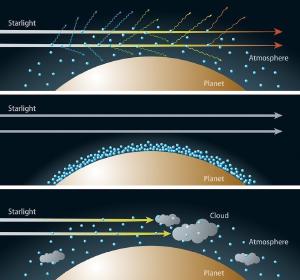Post
Water in the Sky
6 September 2013
The transit method of exoplanet observation looks at the light from a star to observe dips in brightness. When a planet passes in front of a star (transits), it blocks some of the starlight, making the star appear slightly dimmer. Normally when we are looking for exoplanets we simply look for an overall dip in brightness, from which we can determine things such as the size of the planet relative to the star.
But once an exoplanet is known, you can begin to make more subtle observations, such as observing the dip at different wavelengths. This was done by a team recently to study the atmosphere of an exoplanet known as Gliese 1214 b. Their results were recently published in the Astrophysical Journal.1
This particular planet is a “super earth”, with a mass about 6.5 earths, and a diameter about 2.5 times larger than Earth. It orbits a small red dwarf star. Because of the planet’s size and mass, its density is only about twice that of water, which has led some to speculate that it is a watery world with a relatively thick atmosphere. Now in this latest paper there is some evidence to support that idea.
If we could observe the planet directly, it would look like a disk, where the outer edge of the disk is the planets atmosphere. If you’ve seen a picture of Earth from space, you get the idea. As the planet passes in front of the star, the atmosphere starts to block the star before the disk of the planet does. Likewise, as the planet finishes transiting, the disk of the planet unblocks the star before the atmosphere does. So the beginning and ending portions of the transit are more strongly due to the atmosphere of the planet.
The team made observations of planetary transits at different wavelengths, and compared the different dips at those wavelengths to find the amount of light absorbed or scattered by the planet’s atmosphere. They then compared their results to three atmospheric models: one mostly of hydrogen; a water-rich atmosphere (similar to Earth’s); and a highly cloudy atmosphere (such as Venus or Titan). These three different types of atmospheres interact with light in different ways, as seen in the figure below.
 NAOJ
NAOJIn a hydrogen dominated atmosphere, Rayleigh scattering scatters most of the blue light, leaving red wavelengths to dominate. A similar effect occurs in our atmosphere, but to a less extent. You might remember from a previous post that the amount of Rayleigh scattering depends upon the size of atmospheric molecules. Since hydrogen is much much smaller than the nitrogen of our atmosphere, so we would expect more scattering. A water rich atmosphere would have less depth than a hydrogen one, so the absorption and scattering of light would be less severe and more uniform. Finally, a cloudy atmosphere would block much of the light at various wavelengths.
The model that best fit observation was one of a water rich atmosphere similar to our own. This seems to support the idea that Gliese 1214 b is a watery world. Because of this, news of the results have hit the popular press. But the authors note that hydrogen-rich atmosphere with heavy clouds is also a possibility. So while it seems likely that this is a watery world, more observations are needed.
It’s pretty amazing that we are now able to start analyzing the atmospheres of planets around other stars, but it’s even more amazing when you realize these observations were made with a ground based telescope, the Subaru telescope at Mauna Kea.
Narita, Norio, et al. “Multi-color Transit Photometry of GJ 1214b through BJHK s Bands and a Long-term Monitoring of the Stellar Variability of GJ 1214.” The Astrophysical Journal 773.2 (2013): 144. ↩︎